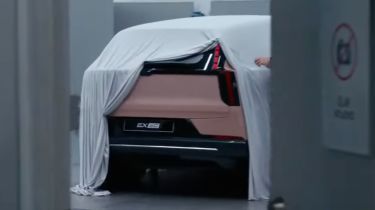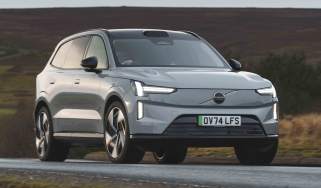New Volvo EX60 partly unveiled in clay model form
It’s the first time Volvo has given us a look at its upcoming electric XC60 alternative

Volvo is in the midst of expanding its range of EVs and coming up soon will be the EX60 - a mid-size electric SUV that’ll target the likes of the Audi Q6 e-tron, Porsche Macan Electric and BMW’s forthcoming Neue Klasse SUV.
We’ve just been given our first official look at the EX60 during Volvo’s reveal of its new electric saloon car, the ES90. A brief glimpse under a cover showcased some of the design cues of the EX60, hinting it’ll continue with the styling already seen on Volvo’s new EVs, from the entry-level EX30 to the flagship EX90.
We can see Volvo’s new rear light signature: a cluster on the rear pillar and a main section on the rear three-quarter – although this element doesn’t extend into the bootlid as it does on the EX30 and EX90. We can expect the ‘Volvo’ script to sit in the middle of the bootlid’s blank surfacing and there looks to be a horizontal strip of silver plastic below that on the rear bumper.

The new car’s overall proportions look similar to the current XC60’s, the car the EX60 will replace when it arrives sometime in 2026, and our exclusive image already shows what the new EX60 could look like. We expect to see the front end use eight-bit-style Thor’s-hammer LED headlights, plus flush door handles, a blanked-off grille and aerodynamic alloy wheels. Volvo hasn’t confirmed whether the advanced LiDAR driver-assistance tech on the EX90 will filter down to ‘lesser’ models, such as the forthcoming EX60, but Chief Product and Strategy Officer Erik Severinson did tell us that the brand is experimenting with “different kinds of [safety] sensors going forward”.
Volvo previously confirmed EX60 will be the first model built on its next-generation SPA3 platform. This is an evolution of the EV architecture that underpins the Volvo EX90 flagship.
Volvo says SPA3 is a far more scalable architecture than its predecessor, which will allow the brand to develop and build cars of all sizes using the same technology. That includes, in theory, smaller models than the 4.2-metre-long EX30 and larger ones than the EX90, which is more than five metres long.
Being scalable also means Volvo can create increased synergies and share key components across all cars built on SPA3, which reduces complexity and can help bring down the cost of production.
Another advance that will set the EX60 apart from other electric Volvos will be its “structural” battery pack. This technology has already been adopted by the likes of Tesla and BYD, and in effect bonds the battery pack with the floor of the car. The result, Severinson told Auto Express, is “improved energy density” and, given the extra structural rigidity, “great driveability”.
Volvo EX60 battery range and capacity
The EX90 uses a huge 107kWh (usable) battery pack that offers a range of 374 miles on a single charge. Given the EX60’s smaller size, we expect to see a slightly more compact, lighter battery fitted to top-spec models. The increased energy density of its structural battery pack could see range figures approaching the 400-mile mark, however.
The incorporation of this new kind of technology is thanks, in part, to the EX60’s megacasted rear underfloor. Unlike most cars, which have rear undercarriages constructed using a multitude of different parts, the EX60 will instead get a single unit that is cast out of aluminium.
We visited the factory in Gothenburg, Sweden, which will assemble the EX60’s floor. Basically following the same manufacturing processes used to build 1:64-scale model cars but greatly enlarged, megacasting is a relatively new concept in the automotive sphere. Tesla is the only other mainstream manufacturer currently adopting the method, along with several Chinese brands such as Nio, Zeekr and XPeng.
Volvo says the new rear floor weighs “15-20 per cent less” than a traditional stamped equivalent and that it offers “just as good, if not better safety and durability”.
There are other incidental benefits from the process, too, including an increased boot capacity and faster production times. A megacasted floor takes 120 seconds to build, compared with a full hour for a multi-piece stamped floor.
Plus, while Volvo’s production process currently uses 20 per cent recycled aluminium, the goal is to increase this figure and fully recycle the megacasted floor at the end of the car’s life.
Buy a car with Auto Express. Our nationwide dealer network has some fantastic cars on offer right now with new, used and leasing deals to choose from...
Find a car with the experts







